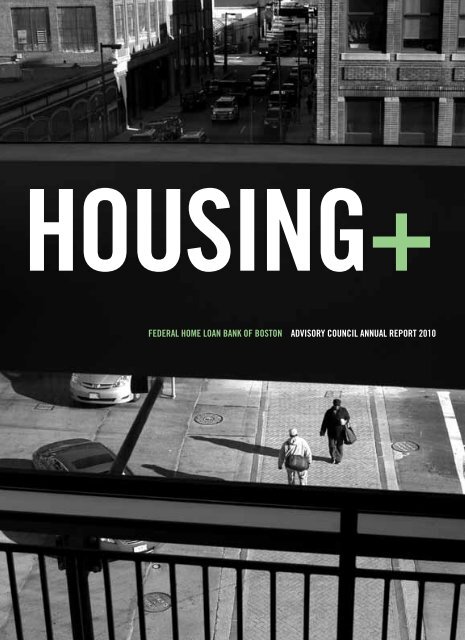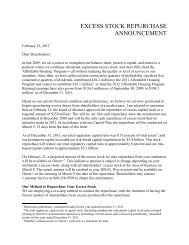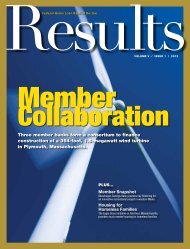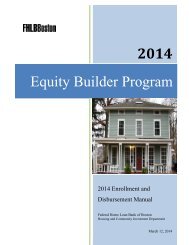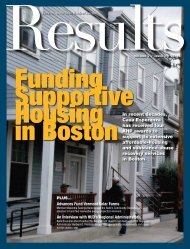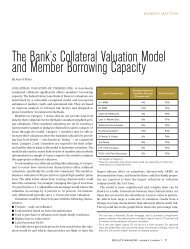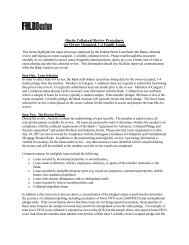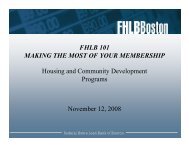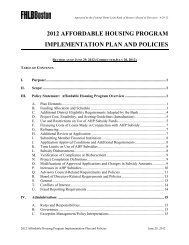2010 FHLBank of Boston Advisory Council Report - Federal ...
2010 FHLBank of Boston Advisory Council Report - Federal ...
2010 FHLBank of Boston Advisory Council Report - Federal ...
You also want an ePaper? Increase the reach of your titles
YUMPU automatically turns print PDFs into web optimized ePapers that Google loves.
Housing+<br />
<strong>Federal</strong> Home Loan Bank <strong>of</strong> <strong>Boston</strong> <strong>Advisory</strong> <strong>Council</strong> Annual <strong>Report</strong> <strong>2010</strong>
The <strong>Advisory</strong> <strong>Council</strong> <strong>of</strong> the <strong>Federal</strong> Home Loan Bank <strong>of</strong> <strong>Boston</strong> was organized in<br />
1990. Appointed by the Bank’s board <strong>of</strong> directors, the council is made up <strong>of</strong><br />
representatives <strong>of</strong> housing and community-development organizations<br />
throughout New England. Each <strong>of</strong> the six New England states is represented on<br />
the council, which meets quarterly. Both as a body and through special<br />
committees, the council advises the Bank and its board on the administration<br />
<strong>of</strong> its special programs for housing and community development.<br />
1 From the Chair<br />
3 Housing+<br />
16 Community Lending Programs<br />
17 Low-Cost Funding for Housing and Community Economic Development<br />
18 <strong>2010</strong> Grants for New England Partnerships<br />
18 Affordable Housing Development Competition<br />
19 <strong>2010</strong> Affordable Housing Program Approvals<br />
20 <strong>2010</strong> <strong>Advisory</strong> <strong>Council</strong><br />
ibc<br />
ibc<br />
<strong>2010</strong> Board <strong>of</strong> Directors, Housing and Community Development Committee<br />
Senior Staff, Housing and Community Investment Department<br />
On the cover: View <strong>of</strong> <strong>Boston</strong>’s South End neighborhood from the AHP-funded Gatehouse development. Construction <strong>of</strong> this mixed-use<br />
initiative on a vacant lot on Washington Street has brought new life and development to this once struggling community.
from the chair<br />
The <strong>Federal</strong> Home Loan Bank <strong>of</strong> <strong>Boston</strong>’s return to pr<strong>of</strong>itability<br />
in <strong>2010</strong> was good news for the Bank’s Affordable Housing Program<br />
(AHP).<br />
In <strong>2010</strong>, the AHP awarded $5.6 million in grants and nearly $12.8 million<br />
in subsidized advances to fund 10 affordable-housing initiatives. As a<br />
result <strong>of</strong> strong support from the Bank’s senior management and board<br />
<strong>of</strong> directors — which voted to advance funds to the AHP by borrowing<br />
from projected future earnings — the <strong>2010</strong> AHP created or preserved<br />
358 rental units and two new Habitat for Humanity homes in communities<br />
across New England. The Bank’s pr<strong>of</strong>itability in <strong>2010</strong> also means<br />
an increase in its 2011 AHP contribution to $11.8 million.<br />
The AHP will also benefit from an agreement the 12 <strong>FHLBank</strong>s reached<br />
on February 28, 2011. The Joint Capital Enhancement Agreement<br />
provides a framework for the handling <strong>of</strong> funds previously used to<br />
satisfy the <strong>FHLBank</strong>s’ obligation to the Resolution Funding Corporation<br />
(REFCorp). Once the REFCorp obligation is satisfied, those funds will<br />
likely result in an additional 20 percent <strong>of</strong> funding for the AHP while<br />
growing total retained earnings and enhancing the safety and soundness<br />
<strong>of</strong> the <strong>FHLBank</strong> System.<br />
In <strong>2010</strong>, the Bank implemented a scoring change to increase the<br />
competitiveness <strong>of</strong> housing preservation in the awarding <strong>of</strong> AHP grants<br />
and subsidized advances. The <strong>Advisory</strong> <strong>Council</strong> recommended the<br />
change because <strong>of</strong> the pressing need to ensure that existing affordable<br />
housing remains affordable over the long run.<br />
Despite continuing s<strong>of</strong>tness in the housing market, the demand for<br />
affordable housing remained strong. In <strong>2010</strong>, 38 member institutions<br />
assisted new homebuyers through the Bank’s Equity Builder Program.<br />
One hundred six low- and moderate-income homebuyers benefited<br />
from $1 million in EBP grants to help them purchase a home. Receiving<br />
these grants is <strong>of</strong>ten the difference between buying and not buying<br />
a first home.<br />
In <strong>2010</strong>, member financial institutions also used $814.6 million<br />
in Community Development advances to support the development<br />
or preservation <strong>of</strong> 2,843 housing units and 67 economic development<br />
or mixed-use initiatives. During this period, the Bank made a special<br />
effort to educate members on the value <strong>of</strong> using the Community<br />
Development advance to support small business and job growth across<br />
the region.<br />
In June, the AHP was named Program <strong>of</strong> the Year by the National<br />
Housing Conference — a testament to the central role the AHP plays<br />
in the nation’s affordable housing community. Representatives <strong>of</strong> the<br />
12 <strong>FHLBank</strong>s were on hand to receive the award at the conference’s<br />
annual gala at the National Building Museum in Washington, D.C.<br />
In <strong>2010</strong>, the Bank also provided new educational opportunities for<br />
member banks, developers, local governments, and others. In October,<br />
the Bank sponsored “Through the Lens <strong>of</strong> Housing: New England<br />
Economic Recovery,” a conference held in Springfield, Massachusetts,<br />
to explore the role housing plays in maintaining a healthy regional<br />
economy. And in June, the Bank collaborated with the <strong>Federal</strong> Reserve<br />
Bank <strong>of</strong> <strong>Boston</strong> to bring together green development experts, lenders,<br />
and investors to discuss the impact green building has on affordable<br />
housing.<br />
A highlight <strong>of</strong> the year for the <strong>Advisory</strong> <strong>Council</strong> was its June meeting<br />
at the AHP-funded Visiting Nurse Association Assisted Living<br />
Community in Somerville, Massachusetts — an innovative, green,<br />
multi-use complex for seniors. Members <strong>of</strong> the council and board <strong>of</strong><br />
directors met at the VNA facility to see firsthand the impact AHP funding<br />
has on local communities. Assisted-living facilities such as the<br />
Somerville VNA will become increasingly important to communities as<br />
the U.S. population ages in the years ahead.<br />
In December, the <strong>Federal</strong> Housing Finance Agency convened its second<br />
meeting with <strong>Advisory</strong> <strong>Council</strong> chairs and vice chairs in Washington,<br />
D.C. These meetings provide an excellent opportunity for the council<br />
to learn more about the activities and programs <strong>of</strong> other <strong>FHLBank</strong>s.<br />
Through attendance at one <strong>of</strong> these meetings, the Bank’s <strong>Advisory</strong><br />
<strong>Council</strong> gained a greater appreciation <strong>of</strong> the role the Bank’s Community<br />
Development advance program plays in promoting the Bank’s affordable<br />
housing and economic development mission across the region.<br />
During my six-year tenure on the council, I have had the opportunity<br />
to work with many dedicated colleagues and friends. Participation on<br />
the council has been an honor and a remarkable education. I have had<br />
the chance to participate in planning several <strong>of</strong> the largest AHP rounds<br />
since the program’s inception as well as work with the Bank’s housing<br />
staff to help preserve critical affordable housing during one <strong>of</strong> the<br />
greatest economic downturns in recent memory.<br />
Affordable housing is important to everyone — to the people who<br />
live in it as well as the communities in which it resides. The stories<br />
that follow testify to the important role the AHP continues to play in<br />
supporting affordable housing and strong, economically viable<br />
communities across New England.<br />
Sincerely,<br />
David H. Wood<br />
Chair <strong>of</strong> the <strong>Advisory</strong> <strong>Council</strong><br />
1
Every time<br />
an Affordable<br />
Housing Program<br />
dollar is spent<br />
in New England,<br />
reverberations<br />
are felt<br />
throughout<br />
local<br />
communities<br />
2
Housing+<br />
Every time an Affordable Housing Program dollar is spent in New England, reverberations are felt throughout local communities.<br />
New housing generates construction jobs and permanent jobs. Mixed-use initiatives provide space for new businesses and<br />
nonpr<strong>of</strong>it service providers.<br />
The construction <strong>of</strong> new housing and commercial space makes life more convenient, the streets more lively and attractive.<br />
In many instances AHP-funded housing is part <strong>of</strong> a broader plan to uplift struggling neighborhoods.<br />
A recent study underscores the impact an AHP subsidy can have on employment, the purchase <strong>of</strong> materials, local spending,<br />
and state and federal taxes. The study states that while the AHP funds only a fraction <strong>of</strong> total development costs, it leverages<br />
substantial funding from other sources to expand economic activity. The study concludes that every $1 million <strong>of</strong> AHP subsidy<br />
contributes to a multiplier effect <strong>of</strong> $14.2 million, a notable benefit beyond the creation and preservation <strong>of</strong> much needed<br />
affordable housing in our region.<br />
The pages that follow highlight the various ways that new affordable housing converges with a broad range <strong>of</strong> community<br />
redevelopment goals to strengthen local communities.<br />
In Tiverton Rhode Island, Sandywoods Farm created new affordable housing for artists, preserved agricultural<br />
and recreational land, created community gardens for residents, and spurred a plan to construct a new town<br />
library.<br />
In Seymour, Connecticut, the conversion <strong>of</strong> an old furniture store to create new affordable senior housing and<br />
commercial space played a critical role in the ongoing revival <strong>of</strong> a historic downtown.<br />
In <strong>Boston</strong>’s South End, the mixed-use Gateway initiative helped breathe new life into a neighborhood struggling<br />
to recover from years <strong>of</strong> neglect.<br />
In Brattleboro, Vermont, the Ann Wilder Richards initiative was part <strong>of</strong> a broader community plan to create a<br />
new senior village in the West Brattleboro section <strong>of</strong> the city.<br />
In Laconia, New Hampshire, the redevelopment <strong>of</strong> a former knitting-machine factory created new affordable<br />
rental housing and ownership space for nonpr<strong>of</strong>it child-care and health-care providers.<br />
In Scarborough, Maine, Bessey Commons Senior Housing played a key role in a plan to create a new community<br />
village that included new retail, <strong>of</strong>fice, and residential space.<br />
AHP-funded housing is inextricably linked to the health and wealth <strong>of</strong> communities. The initiatives highlighted in this year’s<br />
report provide ample evidence <strong>of</strong> the strength and agility <strong>of</strong> the AHP and the essential role it plays in transforming communities<br />
throughout the region.<br />
3
theY didn’t<br />
want<br />
a typical<br />
suburban<br />
subdivision<br />
Sponsor<br />
Member<br />
AHP<br />
Church Community Housing Corporation<br />
BankNewport<br />
$400,000 grant<br />
$2.6 million subsidized advance<br />
$393,391 advance subsidy<br />
4
Sandywoods Farm<br />
Tiverton, Rhode Island<br />
The Community Center Harmony Dietz Joe Bossom<br />
In 2003, Joe Bossom and Mika Seeger<br />
approached Church Community Housing<br />
Corporation about the possibility <strong>of</strong> selling<br />
their farm in Tiverton, Rhode Island, to create<br />
an affordable-housing community for artists.<br />
While a large commercial developer had<br />
expressed interest in the land, the couple<br />
didn’t want to see a typical suburban subdivision<br />
built on productive farm land.<br />
“We spent a long time discussing with them<br />
and the whole community how it could be<br />
done,” says Stephen Ostiguy, executive director<br />
<strong>of</strong> Church Community Housing. “We<br />
also received a grant from the Rhode Island<br />
Foundation to do a planning study.”<br />
Eight years later, Bossom and Seeger’s vision<br />
for the farm became a reality with the opening<br />
<strong>of</strong> Sandywoods Farm, 50 units <strong>of</strong> singlefamily<br />
and duplex affordable rental housing<br />
on the couple’s former farm property. Artists<br />
living at Sandywoods include painters,<br />
musicians, jewelry makers, and others. In<br />
addition to the housing, the development<br />
also includes a community center and an<br />
art gallery.<br />
In subsequent phases <strong>of</strong> this one-<strong>of</strong>-a-kind<br />
initiative, Church Community Housing will<br />
build ownership housing, develop a family<br />
farm, and organize a community gardening<br />
program for residents. A key piece <strong>of</strong> the<br />
Sandywoods plan was to preserve for agriculture<br />
those sections <strong>of</strong> the farm with the<br />
best soil and set aside the less productive<br />
areas for housing.<br />
Of the 194 acres acquired from the original<br />
owners by Church Community Housing and<br />
Tiverton Land Trust, 22 acres will be designated<br />
for agricultural use, 26 for residential<br />
development, two for a new town library, and<br />
96 for a recreational preserve. “We came up<br />
with a plan that ended up increasing agricultural<br />
land and preserving much <strong>of</strong> the parcel<br />
for open space,” says Mr. Ostiguy.<br />
The Sandywoods initiative also includes upto-date<br />
green building features such as a<br />
wind generator to produce much <strong>of</strong> the development’s<br />
energy, use <strong>of</strong> energy-efficient<br />
wet-cellulose insulation, bamboo flooring,<br />
and a high-efficiency heat-pump system.<br />
While there are many examples <strong>of</strong> artist<br />
housing in urban areas, there are few<br />
examples <strong>of</strong> large, permanent housing developments<br />
for artists in rural areas, says<br />
Mr. Ostiguy.<br />
Harmony Dietz, Resident<br />
Sandywoods Farm<br />
I’ve been living here with my two-and-a-halfyear-old<br />
son for about three weeks now. I<br />
heard about Sandywoods Farm from a friend.<br />
I was living in the next town over and decided<br />
to apply. I was looking for a new apartment<br />
but I wasn’t finding anything suitable that<br />
I could afford.<br />
It was a fantastic day when I heard I was<br />
going to be living here, a dream come true to<br />
find this place.<br />
I’m a jeweler and glassblower. I’m setting up<br />
my studio in the house now. I sell my jewelry<br />
to galleries — about 209 carry my work —<br />
throughout the country.<br />
I used to practice with a jeweler in <strong>Boston</strong>. I<br />
had been blowing glass for about 10 years<br />
but was interested in learning metal. I <strong>of</strong>fered<br />
to sweep the jeweler’s floor in return for learning.<br />
She brought me into her studio and<br />
taught me to make her work.<br />
I make most <strong>of</strong> my sales from this piece<br />
(wildflower earrings). They’re reminiscent <strong>of</strong><br />
what this community means to me — the<br />
farming, the fields. Living here is perfect for<br />
me. I like the earthy, organic feeling and try<br />
to get that across in my jewelry.<br />
I use that rusty old anvil over there to get the<br />
texture I want. It belonged to my dad who<br />
was a metalsmith. He was going to get rid <strong>of</strong><br />
it one day but instead passed it down to me.<br />
I remember watching him bang metal on it<br />
when I was growing up in Nevada. That anvil<br />
is part <strong>of</strong> my childhood. It makes me happy<br />
to think I’m using it to make my own jewelry<br />
now.<br />
5
cast aside<br />
by outlying<br />
Malls and<br />
strip malls<br />
Sponsor<br />
Member<br />
AHP<br />
16 Bank Street LLC<br />
Naugatuck Valley Savings and Loan<br />
$400,000 grant<br />
$750,000 subsidized advance<br />
$331,927 advance subsidy<br />
6
16 Bank Street Apartments<br />
Seymour, Connecticut<br />
Joseph Migani<br />
Helen Seder Coquillard<br />
When architect Joseph Migani arrived<br />
in Seymour, Connecticut, the town’s downtown<br />
was struggling. Its commercial heyday<br />
had long since passed, cast aside by outlying<br />
malls and strip malls.<br />
But hidden beneath the surface dilapidation<br />
<strong>of</strong> downtown Seymour was an attractive collection<br />
<strong>of</strong> Victorian-era buildings. “You can<br />
see the gleam in Joe’s eye when he sees an<br />
old building,” says William C. Nimons, senior<br />
vice president at member Naugatuck Valley<br />
Savings and Loan. “Before Joe started down<br />
there, the downtown was a collection <strong>of</strong> old<br />
rundown buildings.”<br />
A principal at O’Reardon Migani Architects,<br />
Mr. Migani began his downtown odyssey by<br />
purchasing and restoring three historic buildings<br />
on Bank Street to create <strong>of</strong>fice space for<br />
his architectural firm and commercial space<br />
for antiques businesses. The son <strong>of</strong> a local<br />
contractor, Mr. Migani oversaw the restoration<br />
work himself, organizing a crew <strong>of</strong> college<br />
students to do the work on weekends<br />
over a 10-year period.<br />
Mr. Migani’s plan was to reinvent downtown<br />
Seymour by creating an antiques destination<br />
to draw people from across the region. To<br />
maintain the momentum created by his first<br />
downtown project, Mr. Migani purchased<br />
and restored two additional Bank Street<br />
buildings to create four more ground-floor<br />
commercial spaces and 12 affordable senior<br />
apartments.<br />
Developed in collaboration with the Seymour<br />
Housing Authority, the housing at 16 Bank<br />
Street allows seniors to live in a lively downtown<br />
neighborhood within walking distance<br />
<strong>of</strong> restaurants, shops, and a movie theater.<br />
“16 Bank Street breathed new life into downtown<br />
and gave the seniors much needed new<br />
housing,” adds Mr. Nimons. “There’s a real<br />
need for subsidized senior housing all along<br />
the valley.”<br />
Mr. Migani says his success with the first<br />
project gave local banks the confidence that<br />
he could make the second project work. With<br />
eight antique shops lining the streets now,<br />
downtown Seymour has become a destination<br />
for antique shoppers from around the<br />
region.<br />
“This was a field <strong>of</strong> dreams project that —<br />
against all odds — succeeded,” says Mr.<br />
Migani. “It goes to show that if you lead,<br />
people will join you in pursuing a communal<br />
goal.”<br />
Helen Seder Coquillard, Resident<br />
16 Bank Street<br />
I came here from Florida about a year ago.<br />
My daughter and I were looking for an apartment<br />
for me when we saw this building.<br />
I was enthralled with the building and the<br />
apartment.<br />
I lived in Seymour when I married my husband,<br />
John Seder. We built a home in Ansonia<br />
and lived there for 22 years. John managed<br />
the family store on Main Street in Seymour<br />
where the theater is now. (She shows a black<br />
and white photo <strong>of</strong> John standing behind the<br />
store counter.)<br />
When my husband retired we moved to<br />
Florida. John’s been gone for 11 years now<br />
and I didn’t like being alone anymore. When<br />
I was sick I didn’t have anyone to take care<br />
<strong>of</strong> me. I decided to come north and be close<br />
to my daughter.<br />
I play bingo once a week at the senior center.<br />
I have several friends in the building, and we<br />
do things together. I have two friends from<br />
Ansonia who have lost their husbands, and<br />
we play cards together once a week.<br />
What I like most about living here is being<br />
close to my daughter. I can hop in my car and<br />
be at her house in five minutes. I locked<br />
myself out once and called her on the phone.<br />
She was here in five minutes with the key.<br />
That means a lot to me.<br />
7
It was a<br />
dreary part<br />
<strong>of</strong> town<br />
For years, the Washington Street gateway to <strong>Boston</strong>’s<br />
South End had suffered from neglect. Buildings were in<br />
disrepair. The streetscape was uninviting. It was a dreary<br />
part <strong>of</strong> town that few people went out <strong>of</strong> their way to<br />
visit.<br />
But over time, the influx <strong>of</strong> artists and the efforts <strong>of</strong> community<br />
organizations to bring new life to the neighborhood<br />
set in motion a revival that continues into the<br />
present.<br />
Playing an important role in the ongoing revival <strong>of</strong> the<br />
neighborhood was the construction <strong>of</strong> Project Place’s<br />
Gatehouse, 14 units <strong>of</strong> rental housing for formerly homeless<br />
residents, <strong>of</strong>fice space for Project Place’s comprehensive<br />
employment-training programs and homegrown<br />
businesses, and a new, ground-floor Myers + Chang<br />
restaurant.<br />
Sponsor<br />
Member<br />
AHP<br />
Interseminarian Project Place<br />
Wainwright Bank & Trust Company<br />
$250,000 grant<br />
8
Gatehouse<br />
<strong>Boston</strong>, Massachusetts<br />
Bianca Thomas<br />
Construction <strong>of</strong> the new building and<br />
the opening <strong>of</strong> a restaurant run by a wellknown<br />
<strong>Boston</strong> chef have inspired other<br />
neighborhood developments, including the<br />
opening <strong>of</strong> several new restaurants nearby.<br />
For more than 40 years, Project Place has<br />
been helping homeless adults become<br />
self-sufficient by providing them with employment<br />
training and help finding housing. “Our<br />
focus has always been on providing resources<br />
that help people get <strong>of</strong>f the street,<br />
not just for a night, but permanently,” says<br />
Marcie B. Laden, Project Place’s director<br />
<strong>of</strong> development.<br />
In the late 1990s, Project Place expanded<br />
its services by creating businesses that employ<br />
the people it serves. The organization<br />
now has landscaping, cleaning and maintenance,<br />
food service, pushcart, and vendingmachine<br />
businesses. Clients are employed<br />
by the organization’s businesses for six to<br />
nine months while receiving training in job<br />
skills such as computer and customer<br />
service.<br />
The Gatehouse project is Project Place’s<br />
first venture into housing. Ms. Laden says<br />
the organization decided to create housing<br />
because they found that some <strong>of</strong> their<br />
programs’ participants struggled to find<br />
affordable housing even after completing<br />
employment training and starting jobs.<br />
Residents <strong>of</strong> Gatehouse’s efficiency apartments<br />
— each <strong>of</strong> which is designed with the<br />
donated services <strong>of</strong> a pr<strong>of</strong>essional interior<br />
designer — also have supportive services<br />
available to them when needed. “The first<br />
year or two after people move out <strong>of</strong> shelter<br />
or a transitional program are critical,” says<br />
Ms. Laden. “It’s a whole new way <strong>of</strong> life for<br />
them, and we felt they needed housing that<br />
was supportive.”<br />
Bianca Thomas, Resident<br />
Gatehouse<br />
I was homeless and knew I needed to stay in<br />
drug treatment for at least a year. I went from<br />
detox to a holding center to a halfway house<br />
to a transitional house. Then I came here.<br />
I have been working at getting back into society.<br />
I have been able to get housing, a job,<br />
and a whole lot <strong>of</strong> other things.<br />
I was tired <strong>of</strong> not having anything, <strong>of</strong> living<br />
with other people, <strong>of</strong> living on people’s<br />
couches, <strong>of</strong> not working and just existing.<br />
I knew there was more to life than that. I knew<br />
I was smart enough and capable enough. But<br />
using drugs — crack cocaine and alcohol<br />
— kept me at a standstill. I didn’t want to do<br />
anything else.<br />
I had to be honest with myself. I knew it<br />
wasn’t going to get any better unless I did<br />
something. Changing your life requires hard<br />
work, patience, perseverance, and not giving<br />
up when something doesn’t go right.<br />
I had to change all the people I used to consider<br />
my friends. I had to change my whole<br />
life. I have more joy now. I don’t have a lot <strong>of</strong><br />
chaos and confusion in my life. My life is plain<br />
and simple. Every day I learn and see something<br />
new.<br />
I work as a chef. I do the deli station and the<br />
salad bar. I love my job so much. I’m 50 years<br />
old and I can’t see myself going anywhere<br />
else.<br />
I have been living here for about three or<br />
four months now. I can stay here indefinitely,<br />
but I don’t want to stay too long. I want to<br />
expand. I don’t want to get comfortable,<br />
complacent.<br />
I want my own apartment. I want to be<br />
able to have my children and grandchildren<br />
come over and stay the night. I have three<br />
children — two girls and a boy — and three<br />
grandsons.<br />
I like having my own place. When I come<br />
home it’s just me. I was always living in a<br />
community setting where everything was<br />
shared. Living independently like this helps<br />
me to grow up.<br />
I don’t see a lot <strong>of</strong> people here. Once in a<br />
while I see someone coming home from work.<br />
I like the quiet. I love my view <strong>of</strong> the city and<br />
the diversity <strong>of</strong> the South End.<br />
On Wednesdays, I have a praise and worship<br />
class at my church from 6:00 to 7:00 o’clock,<br />
then I attend a service from 7:00 to 8:00<br />
o’clock. On Thursdays, I have choir rehearsal<br />
from 7:00 to 8:00 o’clock.<br />
I just realized: Wow I’ve been missing all <strong>of</strong><br />
this. A lot <strong>of</strong> things have been happening in<br />
my life. I have to pinch myself: Is this really<br />
happening to me? Yes it’s really happening<br />
to me.<br />
9
After the<br />
merger<br />
the building<br />
became<br />
vacant<br />
Sponsor<br />
Member<br />
AHP<br />
Housing Vermont and the<br />
Brattleboro Housing Authority<br />
People’s United Bank<br />
$210,000 grant<br />
$225,000 subsidized advance<br />
$38,997 advance subsidy<br />
10
Ann Wilder Richards<br />
Building Redevelopment<br />
Brattleboro, Vermont<br />
For 10 years, the Ann Wilder Richards<br />
Building served as the headquarters <strong>of</strong> several<br />
local banks — First Vermont Bank & Trust<br />
Company and later Banknorth. But after<br />
Banknorth merged with a larger bank, the<br />
building became vacant.<br />
When Mark Richards, the president <strong>of</strong><br />
Richards Group Insurance Company and<br />
owner <strong>of</strong> the building, put the three-story<br />
structure on the market, his goal was to sell<br />
it to a buyer who would use the property to<br />
benefit the local community.<br />
Mr. Richards, whose daughter’s name is on<br />
the cornerstone <strong>of</strong> the building, approached<br />
Christine Hart, executive director <strong>of</strong> the<br />
Brattleboro Housing Authority, to see if her<br />
organization would be interested in purchasing<br />
the structure and converting it to an<br />
assisted-living facility.<br />
Aware <strong>of</strong> the housing authority’s interest in<br />
redeveloping the nearby Hayes Court property<br />
as new senior housing, Mr. Richards<br />
thought that converting the adjacent Richards<br />
building to an assisted living facility would<br />
complement the authority’s plans.<br />
“I took one walk through the building and<br />
said, this is perfect for housing,” says Ms.<br />
Hart, adding that converting the building to<br />
housing would also provide a suitable relocation<br />
site for tenants displaced by the Hayes<br />
Court renovation.<br />
Developed with Low-Income Housing Tax<br />
Credits by Housing Vermont and the housing<br />
authority, the Richards building includes 21<br />
units <strong>of</strong> affordable rental housing — primarily<br />
one-bedroom units designed to appeal to<br />
seniors — and two commercial spaces.<br />
Wells Fargo Advisors leases one <strong>of</strong> the<br />
commercial spaces, while the authority<br />
hopes to lease the second to a business that<br />
will provide services attractive to seniors.<br />
Ms. Hart says the authority’s long-term plan<br />
is to create a senior village in West Brattleboro<br />
that will include a redeveloped Hayes Court<br />
with assisted living, the adjacent Richards<br />
building, and nearby Melrose Terrace — another<br />
housing authority property. When the<br />
redevelopment is complete, senior residents<br />
<strong>of</strong> the Richards building will be able to access<br />
a planned community center at Hayes Court<br />
via a path connecting the two complexes.<br />
Ms. Hart says the authority’s plan reflects a<br />
broader community vision to create a vibrant<br />
village center made up <strong>of</strong> residences, businesses,<br />
and a school. “Our notion is to let it<br />
happen organically, as people use these<br />
buildings and we create space that invites<br />
them to come here, “ says Ms. Hart. “I think<br />
that is pretty typical <strong>of</strong> Vermont.”<br />
Marian Taschereau, Resident<br />
Ann Wilder Richards Building<br />
I’m originally from Pennsylvania, but I grew<br />
up in Connecticut. Most <strong>of</strong> my kids were born<br />
there. My husband was a truck driver, and<br />
when you are married to that kind <strong>of</strong> job you<br />
become a traveler. When my husband’s company<br />
merged, we moved to Illinois. Then that<br />
company went bankrupt and we came here<br />
to live with my daughter, who had moved to<br />
Vermont.<br />
Almost as soon as we got to Vermont, my<br />
husband got sick and went into the Veterans<br />
Administration hospital. He lived only six<br />
months. I was living with my daughter and<br />
her family at the time. I said: I got to make<br />
my own home. I have always had my own<br />
home.<br />
I moved to Hayes Court (public housing adjacent<br />
to the Richards building) and lived<br />
there for about 18 years. I liked living there<br />
because it was near a brook and I woke up<br />
to birds singing. But I had to move when I<br />
started to use walkers because I couldn’t fit<br />
them through the door.<br />
I lived in my new apartment for only two<br />
years. The apartment didn’t have enough<br />
windows. It was depressing having so little<br />
light. I went to the housing authority and they<br />
told me about the Richards building. I moved<br />
here in July and am very happy. My apartment<br />
has lots <strong>of</strong> light.<br />
I’m partial to West Brattleboro because I lived<br />
so long in Hayes Court. I don’t know how<br />
many times they tried to get me to move to<br />
the senior high rise downtown. I told them:<br />
You couldn’t pay me enough money to<br />
live in the high rise. I was born on a farm in<br />
Pennsylvania. I’m not a city person. I hate<br />
city living.<br />
I sold my car and depend on my children to<br />
get me to shops now. One day I realized I<br />
couldn’t drive my car anymore and I sold it.<br />
I have five children, and all <strong>of</strong> them live in<br />
Vermont now.<br />
Marian Taschereau<br />
11
the building<br />
was<br />
Vacant and<br />
dilapidated<br />
Sponsor<br />
Member<br />
AHP<br />
Laconia Housing Authority<br />
Meredith Village Savings Bank<br />
$300,000 grant<br />
$824,000 subsidized advance<br />
$260,173 advance subsidy<br />
12
Scott & Williams Mill Renovation Project<br />
Normandin Apartments<br />
Laconia,New Hampshire<br />
Sherry Chouinard<br />
In the early years <strong>of</strong> the 20th century, the<br />
Scott & Williams knitting machine factory was<br />
a major employer in Laconia, New Hampshire,<br />
manufacturing machines used around the<br />
world.<br />
But like the operators <strong>of</strong> many New England<br />
factories, the manufacturer became a casualty<br />
<strong>of</strong> global competition. In the years that<br />
followed, the factory was converted to shoe<br />
production, but it never regained the dynamism<br />
<strong>of</strong> its early years.<br />
By the late 1970s, space in the complex was<br />
leased to a number <strong>of</strong> small businesses, but<br />
most <strong>of</strong> the building was vacant and dilapidated.<br />
Adjacent to downtown Laconia, the<br />
complex was ripe for redevelopment, but the<br />
community couldn’t reach consensus on<br />
what should be done with it.<br />
In 2001, key elements came together to make<br />
possible the redevelopment <strong>of</strong> the former<br />
factory as a mixed-use, mixed-income initiative,<br />
says Kathy Naczas, former executive<br />
director <strong>of</strong> the Laconia Housing Authority<br />
and now senior community investment<br />
manager at the <strong>Federal</strong> Home Loan Bank<br />
<strong>of</strong> <strong>Boston</strong>.<br />
Ms. Naczas says the owner <strong>of</strong> the property<br />
realized its commercial potential was limited,<br />
while the Laconia Housing Authority <strong>of</strong>fered<br />
a proposal for the site — mixed-income<br />
housing with ground-floor commercial space<br />
for nonpr<strong>of</strong>its — that was acceptable to a<br />
broad range <strong>of</strong> community stakeholders.<br />
Today, Normandin Apartments provides 50<br />
affordable rental apartments, 10 market-rate<br />
units, a child-care center, a health clinic, and<br />
a hospital wellness center. The reuse created<br />
much needed rental housing, located health<br />
and child-care services in affordable condominium<br />
space close to the people who would<br />
use them, and led to the opening <strong>of</strong> several<br />
new businesses in the neighborhood, says<br />
Charlotte DuBois, executive director <strong>of</strong> the<br />
Laconia Housing Authority.<br />
Many jobs available in Laconia are seasonal,<br />
making the need for affordable housing<br />
critical for permanent residents, says Ms.<br />
Naczas. “The only option for many working<br />
people in the area is to find a job in the city<br />
that pays modest wages,” she says. “There<br />
are a lot <strong>of</strong> wealthy people in and around<br />
Laconia — including wealthy vacationers<br />
who own properties on nearby Lake<br />
Winnipesaukee — but your average resident<br />
<strong>of</strong> Laconia <strong>of</strong>ten struggles to find quality<br />
affordable housing.”<br />
Sherry Chouinard, Resident<br />
Normandin Apartments<br />
I was living in an apartment in Laconia for 15<br />
years before I moved here. My old apartment<br />
was rundown and smaller. I was nervous<br />
living there because there were robberies.<br />
I was told the building was no longer going<br />
to be approved for Section 8 because <strong>of</strong><br />
its condition.<br />
My husband was a taxi driver. I moved here<br />
with him, but he didn’t live long after we got<br />
here. He couldn’t walk up the stairs. I have<br />
two kids: one lives in Keene and the other in<br />
Belmont.<br />
I really love it here. I feel relaxed and happy.<br />
The people are friendly. My dad used to<br />
work in this building when it was a shoe<br />
factory. He used to bring me in here when I<br />
was little.<br />
I always wanted my own little house, but my<br />
husband and I weren’t able to buy one. This<br />
is as close as I’m ever going to get to that.<br />
Living here makes me feel like a little kid in a<br />
new home.<br />
I am legally blind and don’t drive. My friends<br />
take me around when I have to go somewhere.<br />
Living here makes it convenient to see<br />
the doctor. All I have to do is go downstairs<br />
and I’m at the clinic.<br />
13
the Stately<br />
building<br />
had outlived<br />
its<br />
usefulness<br />
Sponsor<br />
Member<br />
AHP<br />
Housing Initiatives <strong>of</strong> New England<br />
TD Bank, N.A.*<br />
$400,000 grant<br />
*A member at the time <strong>of</strong> the award in 2006.
Bessey Commons Senior Housing<br />
Scarborough, Maine<br />
Lillian Leach<br />
The Bessey School held a special place<br />
in the memories <strong>of</strong> many residents <strong>of</strong><br />
Scarborough, Maine. Built as the town’s first<br />
high school and later used as a junior high<br />
school, elementary school, and school resource<br />
center, the stately building on Route<br />
1 had outlived its usefulness as a school.<br />
“But there was a great affinity for the building<br />
in the community,” says Cynthia Taylor, president<br />
<strong>of</strong> the nonpr<strong>of</strong>it Housing Initiatives <strong>of</strong><br />
New England, who attended elementary<br />
school in the building and whose father<br />
attended high school there. “Those in<br />
education, those who had gone to school<br />
there, government people, everybody<br />
came together and wanted to see the building<br />
saved.”<br />
The town approached Ms. Taylor to see if her<br />
organization would be interested in converting<br />
the structure to senior housing. Working<br />
closely with the town, Ms. Taylor successfully<br />
applied to the Maine State Housing Authority<br />
for Low-Income Housing Tax Credits to help<br />
finance the initiative.<br />
The conversion involved the historic preservation<br />
<strong>of</strong> the original school — including<br />
some blackboards and classrooms — and<br />
construction <strong>of</strong> a new addition to create 54<br />
affordable apartments for seniors. “Our residents<br />
are generally people who have grown<br />
up in the community and want to stay here,”<br />
says Ms. Taylor. “There is still a need for<br />
senior housing here. We could probably fill<br />
another 54 units without any problem.”<br />
In addition to providing much needed senior<br />
housing, the revival <strong>of</strong> the building has played<br />
a key role in the coastal town’s effort to create<br />
a new community village. New commercial<br />
and <strong>of</strong>fice space was recently built on land<br />
adjacent to Bessey Commons and new residential<br />
and commercial space is under construction<br />
there. The new town village also<br />
includes a new medical service building<br />
nearby and the Maine Veterans Home, where<br />
the spouses <strong>of</strong> some Bessey Commons<br />
residents reside.<br />
Lillian Leach, Resident<br />
Bessey Commons Senior Housing<br />
Before I moved to Bessey Commons, I was<br />
living in an apartment not far from here. I had<br />
a very close friend who lived upstairs. She<br />
passed away very suddenly and I just didn’t<br />
want to stay there anymore.<br />
My daughter Lee Anne, who lives in Wyoming,<br />
kept an eye on Bessey Commons as it was<br />
being built. It was handy to everything.<br />
Living here has been very good for me. I have<br />
my friend Larry next door. We have a buddy<br />
thing going. We check up on each other every<br />
day. Larry lost his wife. He’s always sticking<br />
his head in the door to see if I need anything.<br />
He comes at night to make sure I go to bed<br />
and eat. He is very thoughtful.<br />
People here watch out for me. I guess because<br />
I am 92. There’s a woman here named<br />
Judy who spends four hours on Friday helping<br />
people with lunch and hospital visits.<br />
She’ll do anything to help people. She’s very<br />
nice. I also have a girl with some medical<br />
training who comes in on Mondays and<br />
Wednesdays to help me.<br />
I was born in Woodstock, Maine, and grew<br />
up there and in Vermont. My father was a<br />
railroad man and was transferred to Island<br />
Pond, Vermont, when I was in high school. I<br />
came to Portland to train as a nurse in the<br />
Maine Eye and Ear Infirmary. It was the late<br />
1930s, the Depression, the war years. I was<br />
19. I had two brothers in the service. One<br />
served in France and the other in England.<br />
I wanted to go too but my mother said no.<br />
I graduated from nursing school in 1941.<br />
My daughter has an antiques business in<br />
Casper. She usually comes back three times<br />
a year. She is a very good daughter. She calls<br />
me practically every day.<br />
I have a lot <strong>of</strong> support here. My brother and<br />
his wife live on Forest Avenue, and my sister<br />
and her husband live in Gorham. My niece is<br />
a nurse and comes by every week to check<br />
up on me.<br />
15
community<br />
lending<br />
programs<br />
Grants and Subsidized Loans<br />
for Affordable Housing<br />
The Affordable Housing Program —<br />
Since its inception in 1990, 820 affordablehousing<br />
initiatives have been approved for<br />
funding through the <strong>Federal</strong> Home Loan Bank<br />
<strong>of</strong> <strong>Boston</strong>’s Affordable Housing Program.<br />
In <strong>2010</strong>, the Bank approved over $5.6 million<br />
in grants and subsidies for advances (loans)<br />
to support an additional 10 initiatives.* Once<br />
completed, these projects will provide an<br />
additional 360 affordable homes for New<br />
Englanders and will join the other 22,299 units<br />
that have been approved for funding.<br />
In the past 21 years, through <strong>2010</strong>, the Bank<br />
has committed $187 million in subsidies and<br />
more than $174 million in low-interest loans to<br />
affordable-housing initiatives in the region.**<br />
The AHP allows the Bank to address, in partnership<br />
with member institutions, the affordablehousing<br />
needs <strong>of</strong> communities across New<br />
England. Generally, 10 percent <strong>of</strong> the Bank’s<br />
net earnings subsidizes the program, which<br />
awards grants and low-interest advances<br />
through member institutions.<br />
The program encourages local planning <strong>of</strong><br />
affordable-housing initiatives. The Bank’s<br />
member institutions work with local housing<br />
organizations to apply for funds to support<br />
initiatives that serve very low- to moderate-income<br />
households in their communities. Each<br />
year, funding for projects submitted to the<br />
AHP by member institutions is awarded<br />
competitively.<br />
The initiatives approved in <strong>2010</strong> are listed on<br />
page 21 <strong>of</strong> this report.<br />
The AHP funds the direct costs and related<br />
s<strong>of</strong>t costs for the acquisition, construction, or<br />
rehabilitation <strong>of</strong>:<br />
n Ownership Housing: Including single-family<br />
houses, subdivisions, cooperatives, condominiums,<br />
and down-payment and closingcost<br />
assistance.<br />
n Rental Housing: Including multifamily rental<br />
housing, single-room-occupancy housing,<br />
supportive or special-needs housing, mutual<br />
housing, and mobile-home parks.<br />
AHP Income Guidelines: Ownership housing<br />
affordable to households with incomes up to<br />
80 percent <strong>of</strong> the area median family income.<br />
Rental housing in which at least 20 percent <strong>of</strong><br />
the units are for households with incomes that<br />
do not exceed 50 percent <strong>of</strong> the area median<br />
income.<br />
Grants that Bring Buying a Home<br />
Within Reach<br />
The Equity Builder Program — The<br />
<strong>Federal</strong> Home Loan Bank <strong>of</strong> <strong>Boston</strong>’s Equity<br />
Builder Program <strong>of</strong>fers members grants to<br />
provide households earning no more than 80<br />
percent <strong>of</strong> the area median income with downpayment,<br />
closing-cost, homebuyer counseling,<br />
and rehabilitation assistance. Members may<br />
also use EBP grants to match eligible buyers’<br />
savings. Members are required to use the first<br />
one-third <strong>of</strong> their allocation to fund first-time<br />
homebuyers.<br />
Member institutions first apply to participate in<br />
the EBP. In order to participate, members originate<br />
the buyer’s first mortgage and work with<br />
an experienced, qualified homebuyer counseling<br />
agency to <strong>of</strong>fer buyers homeownership<br />
education. The counseling program must include<br />
pre- and post-purchase counseling as<br />
well as a financial-literacy component alerting<br />
buyers to the characteristics <strong>of</strong> predatory lending.<br />
Members must also provide buyers with<br />
concessions, including waived or reduced fees,<br />
or a reduced interest rate (a rate below that for<br />
a standard, conventional market-rate mortgage),<br />
relaxed underwriting standards, or<br />
down-payment assistance or other cash contribution<br />
made by the member at closing.<br />
Mortgage loans originated with EBP grants<br />
may be sold through the Bank’s Mortgage<br />
Partnership Finance ® (MPF ® ) program, provided<br />
that the mortgages and homeowners continue<br />
to meet the retention requirements <strong>of</strong> the EBP.<br />
In April <strong>of</strong> <strong>2010</strong>, 80 members were approved to<br />
access the EBP’s $1 million grant pool.<br />
Members that distributed <strong>2010</strong> EBP funding are<br />
listed by state.<br />
Connecticut<br />
Liberty Bank (disbursed in 2011)<br />
NewAlliance Bank<br />
People’s United Bank<br />
Savings Institute Bank and Trust Company<br />
Windsor <strong>Federal</strong> Savings & Loan Association<br />
Massachusetts<br />
Berkshire Bank<br />
<strong>Boston</strong> Private Bank & Trust Company<br />
Bridgewater Savings Bank<br />
Bristol County Savings Bank<br />
Citizens-Union Savings Bank<br />
Dedham Institution for Savings<br />
Florence Savings Bank<br />
GFA <strong>Federal</strong> Credit Union<br />
HarborOne Credit Union<br />
Leader Bank, N.A.<br />
Legacy Banks<br />
Millbury <strong>Federal</strong> Credit Union<br />
Pentucket Bank<br />
PeoplesBank<br />
Randolph Savings Bank<br />
Savers Co-Operative Bank<br />
Southbridge Savings Bank<br />
St. Jean’s Credit Union<br />
St. Mary’s Credit Union<br />
The Bank <strong>of</strong> Canton<br />
Webster First <strong>Federal</strong> Credit Union<br />
Maine<br />
Bangor Savings Bank<br />
Kennebec Savings Bank<br />
Norway Savings Bank<br />
Saco & Biddeford Savings Institution<br />
New Hampshire<br />
Northway Bank<br />
Rhode Island<br />
Bank Rhode Island<br />
Coastway Community Bank<br />
Vermont<br />
Community National Bank<br />
Mascoma Savings Bank, FSB<br />
National Bank <strong>of</strong> Middlebury<br />
NorthCountry <strong>Federal</strong> Credit Union<br />
Northfield Savings Bank<br />
* Please note that all figures provided are accurate<br />
as <strong>of</strong> the close <strong>of</strong> the <strong>2010</strong> AHP round. AHP funding<br />
may have been deobligated if an approved initiative<br />
did not adhere to eligibility criteria. This total also<br />
does not reflect initiatives approved and funded<br />
as alternates.<br />
** These figures represent the units and subsidy<br />
outstanding as <strong>of</strong> year-end <strong>2010</strong> net <strong>of</strong> deobligated<br />
AHP funds and including initiatives that were funded<br />
as alternates.<br />
“Mortgage Partnership Finance,” “MPF,” and “eMPF” are registered trademarks <strong>of</strong> the <strong>Federal</strong> Home Loan Bank <strong>of</strong> Chicago.<br />
16
The EBP may be used to provide up to $10,000<br />
per eligible buyer for:<br />
n Down-payment assistance.<br />
n Closing-cost assistance.<br />
n Payment <strong>of</strong> rehabilitation costs associated<br />
with acquisition.<br />
n Payment <strong>of</strong> counseling costs not covered<br />
by another funding source. However, any<br />
EBP funding used to cover the cost <strong>of</strong><br />
homebuyer counseling must flow directly<br />
to the counseling agency providing the<br />
education.<br />
And in conjunction with any <strong>of</strong> the above,<br />
n Supplementing a homebuyer’s savings<br />
through an Individual Development Account<br />
or matched-savings program.<br />
EBP Income Guidelines: Homebuyers with<br />
incomes no more than 80 percent <strong>of</strong> the area<br />
median family income.<br />
Low-Cost Funding<br />
for Housing<br />
and Community<br />
Economic<br />
Development<br />
Like the Affordable Housing Program,<br />
Community Development advances and the<br />
New England Fund support affordable-housing<br />
initiatives across New England. But unlike the<br />
AHP, both can also be used to fund economicdevelopment<br />
or mixed-use initiatives. Both<br />
programs provide member institutions with<br />
favorably priced loans to support affordablehousing<br />
or community-development initiatives<br />
that meet program guidelines.<br />
Community Development Advances<br />
— Whether a community needs capital for small<br />
businesses, fixed-rate financing for affordable<br />
housing, or improvements to local roads or<br />
schools, members can turn to the <strong>Federal</strong><br />
Home Loan Bank <strong>of</strong> <strong>Boston</strong>’s Community<br />
Development advances.<br />
In <strong>2010</strong>, members used $814.6 million in<br />
Community Development advances to help finance<br />
2,843 units <strong>of</strong> housing and 67 economicdevelopment<br />
or mixed-used initiatives. Since<br />
1990, the Bank has approved $13.4 billion in<br />
Community Development advances (and the<br />
Community Investment Program advances they<br />
replaced) to fund 63,358 units <strong>of</strong> housing and<br />
960 economic-development or mixed-used<br />
initiatives.<br />
The New England Fund — The New<br />
England Fund provides member financial<br />
institutions with advances to support housing<br />
and community-development initiatives<br />
that serve moderate-income households and<br />
neighborhoods. The NEF serves a broader<br />
range <strong>of</strong> moderate-income households than<br />
the Community Development advance and<br />
provides special flexibility for mixed-income<br />
residential development.<br />
In <strong>2010</strong>, the Bank approved more than $18.9<br />
million through the NEF to finance 14 initiatives<br />
that will create a total <strong>of</strong> 617 units, 200 <strong>of</strong> which<br />
will be affordable to households earning at or<br />
below 80 percent <strong>of</strong> the area median income.<br />
Since 1990, the Bank has approved $8.4 billion<br />
under the NEF to finance the construction or<br />
rehabilitation <strong>of</strong> 21,002 housing units.<br />
Community Development advances and the<br />
NEF support loans for the acquisition, refinancing,<br />
construction, or rehabilitation <strong>of</strong>:<br />
n Ownership and Rental Housing: Including<br />
single-family, cooperative, condominium,<br />
single-room-occupancy, and multifamily<br />
housing.<br />
n First-Time Homebuyer Programs or<br />
Residential Lending Programs Targeted to<br />
Eligible Households.<br />
n Economic Development: Including loans or<br />
lending programs for small businesses;<br />
social-service or public-facility initiatives;<br />
infrastructure improvements; and retail,<br />
commercial, industrial, or manufacturing<br />
spaces.<br />
n Mixed-Use Initiatives: These advances can<br />
also be used to fund initiatives that involve<br />
a combination <strong>of</strong> housing and eligible economic<br />
development.<br />
CDA Program Income Guidelines Effective<br />
March 15, 2011:<br />
CDA Extra – Housing that benefits individuals<br />
or households with incomes no more than 115<br />
percent <strong>of</strong> the area median family income.<br />
Economic-development that creates or retains<br />
jobs for workers with annual salaries no more<br />
than 80 percent <strong>of</strong> area median income; is located<br />
in a census tract at or below 80 percent<br />
<strong>of</strong> the area median income; or is located in a<br />
Native American area, a Champion or Enterprise<br />
Community, or an Empowerment Zone.<br />
Mixed-use initiatives must meet the eligibility<br />
requirements for both housing and economicdevelopment<br />
initiatives.<br />
CDA – Economic development that benefits<br />
households with incomes no more than 100<br />
percent <strong>of</strong> area median income for an urban<br />
initiative or at or below 115 percent <strong>of</strong> area<br />
median income for a rural initiative; or is located<br />
in a Native American area, a Champion or<br />
Enterprise Community, an Empowerment Zone,<br />
a brownfield, an area affected by the closing <strong>of</strong><br />
a military base, a state-declared or federally<br />
declared disaster area, or a census tract no<br />
more than 100 percent <strong>of</strong> area median income<br />
for an urban initiative or at or below 115 percent<br />
<strong>of</strong> area median income for a rural initiative.<br />
Mixed-use initiatives must meet the eligibility<br />
requirements for economic-development<br />
initiatives.<br />
New England Fund Income Guidelines:<br />
Housing that serves residents earning at or<br />
below 140 percent <strong>of</strong> the area median family<br />
income or under certain state programs that<br />
targets between 20 and 25 percent <strong>of</strong> its units<br />
to households earning no more than 80 percent<br />
<strong>of</strong> the area median family income. Economic<br />
developments that benefit households or neighborhoods<br />
with incomes up to 140 percent <strong>of</strong><br />
the area median family income.<br />
17
<strong>2010</strong> grants for new england partnerships<br />
The <strong>2010</strong> Program<br />
Through its Grants for New England Partnerships program, the <strong>Federal</strong> Home Loan Bank <strong>of</strong> <strong>Boston</strong> awarded $1,000 to nonpr<strong>of</strong>it organizations on behalf <strong>of</strong> member<br />
institutions who submitted and disbursed a CDA application for the first time in <strong>2010</strong> or a CDA application supporting lending opportunities that will help to keep<br />
homeowners in their homes.<br />
In <strong>2010</strong>, the Bank awarded a total <strong>of</strong> $25,000 in grants to 21 nonpr<strong>of</strong>it organizations on behalf <strong>of</strong> 22 member institutions.<br />
<strong>2010</strong> GNP Recipients<br />
NONPROFIT<br />
Habitat for Humanity North Central ma<br />
A Baby Center<br />
Rhode Island Community Food Bank<br />
Housing Corporation <strong>of</strong> Arlington<br />
Genesis Community Loan Fund<br />
The Canton Emergency Fuel Bank<br />
Northeast Kingdom Community Action (Annual Hunger Fest Campaign)<br />
Portal <strong>of</strong> Hope<br />
Malta, Inc.<br />
Martha’s Vineyard Boys & Girls Club, Inc.<br />
Klingberg Family Centers<br />
The Food Bank <strong>of</strong> Western Massachusetts<br />
The Children’s Museum <strong>of</strong> New Hampshire<br />
Neighborhood Housing Services <strong>of</strong> the South Shore Inc.<br />
Old Sturbridge Village, Inc.<br />
The Children’s Museum in Easton Hand-in-Hand Program<br />
Neighborhood Housing Services <strong>of</strong> Waterbury, Inc.<br />
Concord Boys & Girls Club<br />
Child and Family Services<br />
Windham Area Interfaith Ministry (WAIM)<br />
Sunrise Family Resource Center, Inc.<br />
Braintree Rotary Club<br />
YMCA <strong>of</strong> Central Massachusetts<br />
Y.O.U., Inc.<br />
St. Mary’s Schools Advancement Program<br />
memBER<br />
avidia Bank<br />
Bank <strong>of</strong> Cape Cod<br />
Bank Rhode Island<br />
Brookline Bank<br />
Camden National Bank<br />
Collinsville Savings Society<br />
Community National Bank<br />
eagle Bank<br />
eastern <strong>Federal</strong> Bank<br />
edgartown National Bank<br />
Farmington Bank<br />
Freedom Credit Union<br />
hampshire First Bank<br />
harborOne Credit Union<br />
hometown Bank, A Co-Operative Bank<br />
mansfield Co-Operative Bank<br />
naugatuck Savings Bank<br />
northway Bank<br />
Passumpsic Savings Bank<br />
savings Institute Bank and Trust Company<br />
The Bank <strong>of</strong> Bennington<br />
The Braintree Co-Operative Bank<br />
The Hanover Insurance Company<br />
Webster First <strong>Federal</strong> Credit Union<br />
Westfield Bank<br />
Affordable Housing<br />
Development Competition<br />
The need for affordable housing in Greater <strong>Boston</strong><br />
continues to grow, affecting homeowners and renters<br />
at every income level. To help foster the solutions and<br />
partnerships needed to solve this crisis, the <strong>Federal</strong><br />
Home Loan Bank <strong>of</strong> <strong>Boston</strong>, the <strong>Boston</strong> Society <strong>of</strong><br />
Architects/AIA, Kevin P. Martin & Associates, P.C.,<br />
ICON architecture, inc., and Citizens’ Housing and<br />
Planning Association sponsored the Affordable<br />
Housing Development Competition. The competition<br />
pairs <strong>Boston</strong>-area graduate students with housing<br />
pr<strong>of</strong>essionals to develop innovative proposals for<br />
affordable housing.<br />
In its 10th year, the Affordable Housing Development<br />
Competition was again a great success. Thirty-seven<br />
students from four colleges and universities had the<br />
unique educational opportunity to test their ideas in<br />
action. Meanwhile, five community-development organizations<br />
participated — each with a distinct site,<br />
vision, and community.<br />
<strong>2010</strong> Winners<br />
The winners <strong>of</strong> the <strong>2010</strong> Affordable Housing<br />
Development Competition were as follows:<br />
First Place: $10,000<br />
Shawknit Mill, Lowell, Massachusetts<br />
Organization: Coalition for a Better Acre.<br />
Student Team: Harvard University: Jorge Colon,<br />
Joseph Martinez (Graduate School <strong>of</strong> Design), Julie Leadbetter (Kennedy School <strong>of</strong> Government);<br />
Terra Rogers (Business School); Massachusetts Institute <strong>of</strong> Technology: Julie Chan, Alexis Taylor, and<br />
Jasmine Tillu (Department <strong>of</strong> Urban Studies and Planning); Yan-Ping Wang, (School <strong>of</strong> Architecture).<br />
Faculty Advisor: Leland Cott, Harvard University Graduate School <strong>of</strong> Design.<br />
Design Mentors: Kendra Halliwell, ICON architecture, inc.; Seth H<strong>of</strong>fman, Affiliated Projects;<br />
Paul Silverstone, MassHousing.<br />
Finance Mentor: Peter Hollands, <strong>Boston</strong> Private Bank & Trust Company.<br />
Shawknit Mill is the adaptive reuse <strong>of</strong> a historic mill building near a major transit and retail corridor<br />
in Lowell, Massachusetts. The community-driven project calls for the conversion <strong>of</strong> the vacant mill<br />
to create 53 affordable rental apartments for families.<br />
Second Place: $6,000<br />
The Village at Walnut, Brookline, Massachusetts<br />
Organization: Brookline Housing Authority.<br />
Student Team: Harvard University: Jeffrey Goodman and Aaron Wasserman (Graduate School <strong>of</strong><br />
18
<strong>2010</strong> Affordable Housing Program Approvals<br />
Kent, Connecticut<br />
Union Savings Bank<br />
Kent Affordable Housing, Inc.<br />
5 rental units<br />
$208,289 grant and subsidy, $210,000 advance<br />
Stuart Farm Apartments<br />
Newington, Connecticut<br />
Webster Bank, N.A.<br />
Women’s Institute for Housing & Economic Development, Inc.<br />
74 rental units<br />
$800,000 grant and subsidy, $3.3 million advance<br />
Victory Gardens<br />
New London, Connecticut<br />
Liberty Bank<br />
Habitat for Humanity <strong>of</strong> Southeastern Connecticut<br />
2 ownership units<br />
$50,000 grant<br />
Fitch Avenue Homes<br />
Old Saybrook, Connecticut<br />
Liberty Bank<br />
Women’s Institute Realty <strong>of</strong> Connecticut, Inc.<br />
16 rental units<br />
$587,158 grant and subsidy, $600,000 advance<br />
Ferry Crossing<br />
Somers, Connecticut<br />
Rockville Bank<br />
Somers Housing Authority<br />
60 rental units<br />
$799,080 grant and subsidy, $2.25 million advance<br />
Woodcrest Elderly Housing Expansion - Phase II<br />
<strong>Boston</strong>, Massachusetts<br />
Bank <strong>of</strong> America Rhode Island, N.A.<br />
Planning Office for Urban Affairs<br />
80 rental units<br />
$795,339 grant and subsidy, $3.5 million advance<br />
St. Kevin’s Redevelopment<br />
<strong>Boston</strong>, Massachusetts<br />
<strong>Boston</strong> Private Bank & Trust Company<br />
Dorchester Bay Economic Development Corporation<br />
$486,120 grant and subsidy, $750,000 advance<br />
49 rental units<br />
Quincy Heights 2<br />
Sandwich, Massachusetts<br />
Cape Cod Five Cents Savings Bank<br />
Housing Assistance Corporation<br />
10 rental units<br />
$436,306 grant and subsidy, $240,500 advance<br />
Community Green SPO Units<br />
Manchester, New Hampshire<br />
Merrimack County Savings Bank<br />
Harbor Homes, Incorporated<br />
26 rental units<br />
$799,799 grant and subsidy, $1,315,390 advance<br />
Manchester Somerville St. Veterans FIRST Project<br />
North Smithfield, Rhode Island<br />
Bank <strong>of</strong> America Rhode Island, N.A.<br />
NeighborWorks Blackstone River Valley<br />
38 rental units<br />
$673,057 grant and subsidy, $625,000 advance<br />
Marshfield Commons<br />
Please note that while the information presented is accurate as <strong>of</strong> the date the AHP awards were made, the member institution and sponsor affiliated with an<br />
approved initiative may have since changed. AHP funding may have been deobligated if an approved initiative did not adhere to eligibility criteria. A list <strong>of</strong> initiatives<br />
approved might not include those that were funded as alternates.<br />
Design); Massachusetts Institute <strong>of</strong> Technology: Mai Dang, Kevin Feeney, Laura Manville, Eric Scanlon,<br />
and Heshuang Zeng (Department <strong>of</strong> Urban Studies and Planning).<br />
Faculty Advisor: Lawrence Vale, Massachusetts Institute <strong>of</strong> Technology — Department <strong>of</strong> Urban<br />
Studies and Planning.<br />
Design Mentors: Meera Deean, Affiliated Projects; Margaret Minor Wood, Pinck & Co.<br />
Finance Mentor: Stephen Pratt-Otto, Wainwright Bank & Trust Company.<br />
The Village at Walnut proposes the green modernization <strong>of</strong> a public housing development in<br />
Brookline, Massachusetts. The plan calls for the renovation <strong>of</strong> one building and the replacement <strong>of</strong><br />
three others to create 164 affordable apartments for seniors, the disabled, and families.<br />
Third Place: $3,000<br />
Union Center, Somerville, Massachusetts<br />
Organization: Somerville Community Corporation.<br />
Student Team: Harvard University: Nicholas Bonard, Daniel Hadley, Braham Boyce Ketcham, and<br />
Adam Wodka (Graduate School <strong>of</strong> Design); Dennis Cabrera, Garima Jain, and Jayant Kairam (Kennedy<br />
School <strong>of</strong> Government); Massachusetts Institute <strong>of</strong> Technology: Anne Bowman (Department <strong>of</strong> Urban<br />
Studies and Planning).<br />
Faculty Advisor: Brian Blaesser, Harvard University — Graduate School <strong>of</strong> Design.<br />
Design Mentors: Michelle Apigian, ICON architecture, inc.; Patricia DeLauri, Shepley Bulfinch.<br />
Finance Mentor: Michael Rosenberg, Bank <strong>of</strong> America Rhode Island, N.A.<br />
Union Center is a mixed-use, mixed-income development in Union Square, Somerville. The proposal<br />
includes 29 affordable apartments, 19 market-rate apartments, ground-floor retail space, a community<br />
center, parking spaces, and a park.<br />
<strong>2010</strong> Judges<br />
Lauren Baumann, New Ecology, Inc.<br />
Louise Elving, Viva Consulting<br />
Judy Jacobson, Massachusetts Housing<br />
Partnership<br />
Jennifer Raitt, Metropolitan Area Planning <strong>Council</strong><br />
Peter D. Roth, New Atlantic Development<br />
Corporation<br />
St. John Smith, <strong>Boston</strong> Housing Authority<br />
Other Finance Mentors<br />
Laura Hackell, Consultant<br />
Peter Macero, RBS Citizens, National Association<br />
Other Design Mentors<br />
Vickie Alani, ADD, Inc.<br />
Jonathan MacPhee, J.S. MacPhee Company<br />
Neal Mongold, The Narrow Gate Alternatives in<br />
Architecture LLP<br />
Ross Speer, Mostue & Associates Architects, Inc.<br />
19
<strong>2010</strong> <strong>Advisory</strong> <strong>Council</strong><br />
David H. Wood<br />
Chair <strong>of</strong> the <strong>Advisory</strong> <strong>Council</strong><br />
Executive Director<br />
Rosemary M. Heard<br />
Vice Chair <strong>of</strong> the <strong>Advisory</strong> <strong>Council</strong><br />
President and Chief Executive<br />
Thomas Callahan<br />
Executive Director<br />
Massachusetts Affordable<br />
Sarah E. Carpenter<br />
Executive Director<br />
Vermont Housing Finance<br />
Dean J. Christon<br />
Executive Director<br />
New Hampshire Housing<br />
Affordable Housing, Education<br />
Officer<br />
Housing Alliance (MAHA)<br />
Agency<br />
Finance Authority<br />
& Development, Inc.<br />
CATCH Neighborhood Housing<br />
<strong>Boston</strong>, Massachusetts<br />
Burlington, Vermont<br />
Bedford, New Hampshire<br />
Littleton, New Hampshire<br />
Concord, New Hampshire<br />
Elizabeth B. Crum<br />
Director <strong>of</strong> Real Estate<br />
Development<br />
Julie M. Iffland<br />
Executive Director<br />
Randolph Area Community<br />
Jean M. Johnson<br />
Executive Director<br />
House <strong>of</strong> Hope Community<br />
Dennis J. Lajoie<br />
Director <strong>of</strong> Real Estate<br />
& Subsidiary Operations<br />
Josephine McNeil<br />
Executive Director<br />
CAN-DO<br />
Women’s Institute for Housing<br />
Development<br />
Development Corporation<br />
Community Concepts, Inc.<br />
Newton, Massachusetts<br />
& Economic Development<br />
Randolph, Vermont<br />
Warwick, Rhode Island<br />
South Paris, Maine<br />
Middletown, Connecticut<br />
The <strong>Advisory</strong> <strong>Council</strong> <strong>of</strong> the <strong>Federal</strong> Home Loan Bank<br />
<strong>of</strong> <strong>Boston</strong> advises the Bank and its board <strong>of</strong> directors<br />
on the administration <strong>of</strong> its special programs for housing<br />
and community development.<br />
Organized in 1990, the council is made up <strong>of</strong> representatives<br />
<strong>of</strong> housing and community-development organizations<br />
throughout New England. Each <strong>of</strong> the New England<br />
states is represented on the council, which meets<br />
quarterly.<br />
Diane Randall<br />
Director<br />
Partnership for Strong<br />
Communities<br />
Hartford, Connecticut<br />
Dana W. Totman<br />
President and Chief Executive<br />
Officer<br />
Avesta Housing<br />
Portland, Maine<br />
Richard Williams<br />
Executive Director<br />
Vermont State Housing<br />
Authority<br />
Montpelier, Vermont<br />
Not pictured:<br />
Frank Shea<br />
Executive Director<br />
Olneyville Housing Corporation<br />
Providence, Rhode Island<br />
20
<strong>2010</strong> board <strong>of</strong> directors<br />
Andrew J. Calamare<br />
President and<br />
Chief Executive Officer<br />
Life Insurance Association <strong>of</strong><br />
Massachusetts<br />
<strong>Boston</strong>, Massachusetts<br />
Joan Carty<br />
President and<br />
Chief Executive Officer<br />
Housing Development Fund<br />
Stamford, Connecticut<br />
Stephen F. Christy<br />
President and<br />
Chief Executive Officer<br />
Mascoma Savings Bank, FSB<br />
Lebanon, New Hampshire<br />
Patrick E. Clancy<br />
President and<br />
Chief Executive Officer<br />
The Community Builders, Inc.<br />
<strong>Boston</strong>, Massachusetts<br />
Steven A. Closson<br />
President and<br />
Chief Executive Officer<br />
Androscoggin Savings Bank<br />
Lewiston, Maine<br />
Peter F. Crosby<br />
President and<br />
Chief Executive Officer<br />
Passumpsic Savings Bank<br />
St. Johnsbury, Vermont<br />
John H. Goldsmith<br />
Director<br />
Capital Securities<br />
Management, Inc.<br />
<strong>Boston</strong>, Massachusetts<br />
Cornelius K. Hurley<br />
Director<br />
Morin Center for Banking and<br />
Financial Law<br />
<strong>Boston</strong> University School <strong>of</strong> Law<br />
<strong>Boston</strong>, Massachusetts<br />
A. James Lavoie<br />
Trustee<br />
Middlesex Savings Bank<br />
Natick, Massachusetts<br />
Mark E. Macomber<br />
President and<br />
Chief Executive Officer<br />
Litchfield Bancorp<br />
Litchfield, Connecticut<br />
Jay F. Malcynsky, Vice Chair<br />
Managing Partner<br />
Gaffney Bennett & Associates<br />
New Britain, Connecticut<br />
Kevin M. McCarthy<br />
President and<br />
Chief Executive Officer<br />
Newport <strong>Federal</strong> Savings Bank<br />
Newport, Rhode Island<br />
Jan A. Miller, Chair<br />
President and<br />
Chief Executive Officer<br />
Wainwright Bank & Trust<br />
Company<br />
<strong>Boston</strong>, Massachusetts<br />
Gerald T. Mulligan<br />
Director<br />
Savings Bank Life Insurance<br />
Company <strong>of</strong> Massachusetts<br />
Woburn, Massachusetts<br />
Emil J. Ragones<br />
Executive in Residence<br />
Accounting Management<br />
Solutions, Inc.<br />
Waltham, Massachusetts<br />
Housing and Community<br />
Development Committee<br />
Patrick E. Clancy<br />
Chair<br />
Peter F. Crosby<br />
Vice Chair<br />
Joan Carty<br />
Gerald T. Mulligan<br />
as <strong>of</strong> December 31, <strong>2010</strong><br />
Senior Staff<br />
Edward A. Hjerpe III<br />
President and Chief Executive Officer<br />
M. Susan Elliott<br />
Executive Vice President,<br />
Chief Business Officer<br />
Frank Nitkiewicz<br />
Executive Vice President,<br />
Chief Financial Officer<br />
Janelle K. Authur<br />
Senior Vice President,<br />
Executive Director <strong>of</strong> Human Resources<br />
Timothy J. Barrett<br />
Senior Vice President,<br />
Treasurer<br />
Earl W. Baucom<br />
Senior Vice President,<br />
Chief Operations Officer<br />
George H. Collins<br />
Senior Vice President,<br />
Chief Risk Officer<br />
Carol Hempfling Pratt<br />
Senior Vice President,<br />
General Counsel, Corporate Secretary<br />
Housing and Community<br />
Investment Department<br />
Kenneth A. Willis<br />
Vice President, Director <strong>of</strong> Housing<br />
and Community Investment<br />
Mary Ellen D. Jutras<br />
Assistant Vice President,<br />
Deputy Director<br />
Theo Noell<br />
Manager <strong>of</strong> Programs and Outreach<br />
Tobi Goldberg<br />
Senior Community Investment Manager<br />
Kathy Naczas<br />
Senior Community Investment Manager<br />
Christine Rogers<br />
Senior Community Investment Manager<br />
Paulette E. Vass<br />
Community Development Advance Manager<br />
April Varricchio<br />
HCI Compliance Analyst II<br />
The <strong>Federal</strong> Home Loan Bank <strong>of</strong> <strong>Boston</strong> is a cooperatively owned wholesale bank for the six New England states. Its mission is to support the<br />
residential-mortgage and community-development lending activities <strong>of</strong> its members, which numbered 459 financial institutions as <strong>of</strong> December<br />
31, <strong>2010</strong>. To accomplish its mission, the Bank utilizes private-sector capital to provide members and other qualified customers with reliable<br />
access to low-cost wholesale funds, liquidity, a competitive outlet for the sale <strong>of</strong> loans, special lending programs, technical assistance, and other<br />
products and services.
FHLB<strong>Boston</strong><br />
<strong>Federal</strong> Home Loan Bank <strong>of</strong> <strong>Boston</strong><br />
111 Huntington Avenue<br />
<strong>Boston</strong>, Massachusetts 02199<br />
www.fhlbboston.com<br />
FSC logo


